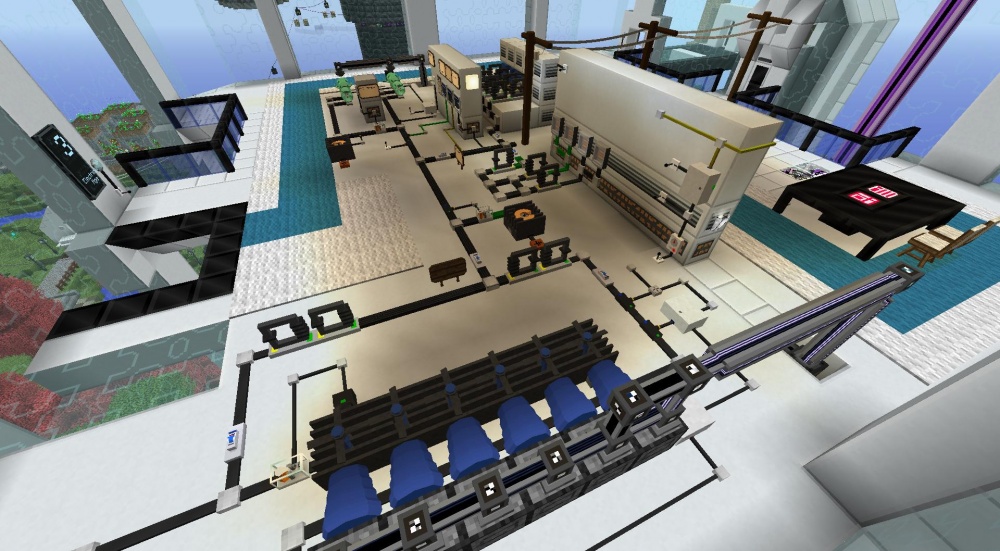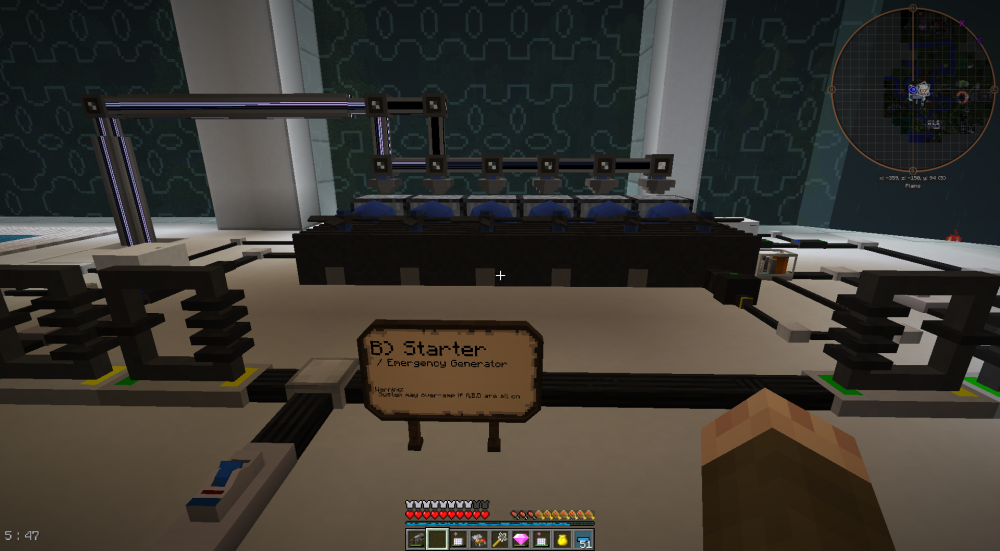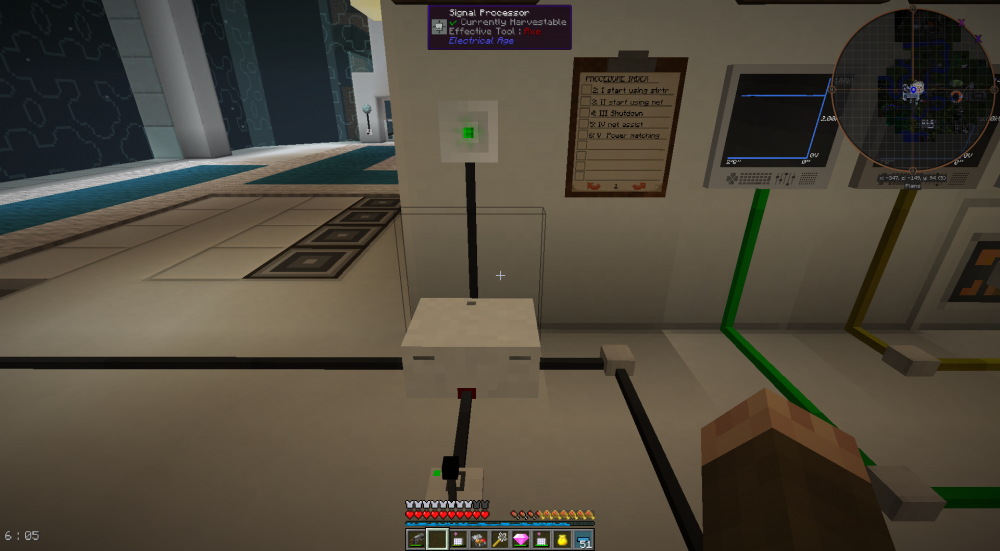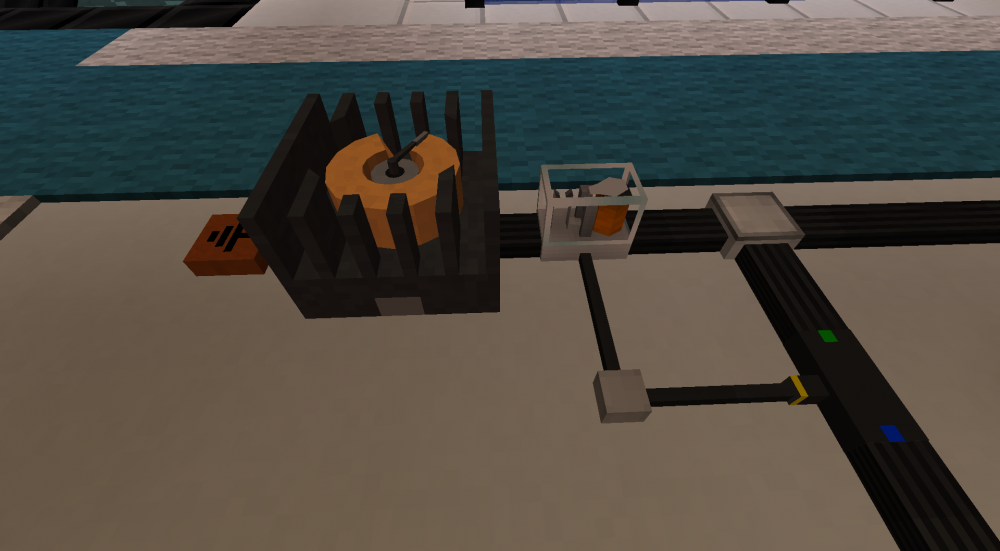Difference between revisions of "Simple gas turbine control"
(initial braindump) |
(→See Also) |
||
| (27 intermediate revisions by 3 users not shown) | |||
| Line 1: | Line 1: | ||
| − | + | == Getting it working == | |
| − | + | You can actually pretty much run a gas turbine without anything fancy. Part of the fun of the gas turbine is figuring it out for yourself ;-) | |
| − | + | ||
| − | + | You will need a signal processor or two, but nothing more complicated than A * B * C. | |
| − | + | ||
| − | + | [[Image:gasgen1_context.jpg|1000px|thumb|A view on a small but somewhat complete single -floor electrical age build, focusing on the gas turbines (to the rear) starter (front), and some support electronics in between. Other systems visible here are a status panel; a rear view on the lighting control system for large tower, and a high-power processing chain. Note also fuel delivery per applied energistics in this case. (a separate mod, not required!). ]] | |
| − | + | {{-}} | |
| − | + | Ok, this looks a bit complicated, but bear with me, it's really just a few simple subsystems. To begin with ... a gas generator can't start by itself. It needs a starter. | |
| − | + | [[Image:gasgen2_starter.png|1000px|thumb|A slightly overpowered starter (it can also serve as an independent emergency power supply), usually 3 heat turbines is sufficient]] | |
| − | + | {{-}} | |
| − | + | Your old 200V setup can do that, all you need to do is step up the voltage to 3200V using transformers. Generators will generate electricity when they spin ... but they also work backwards: you can apply power to spin them up. | |
| − | + | [[Image:gasgen3_actual.png|1000px|thumb|A gas turbine with 2 attached generators. Note the vacuum hopper to guard against accidents.]] | |
| − | + | {{-}} | |
| − | + | Once you get the turbine and generators over 600 RPM (and ensure the turbine gets fed some form of fuel like syngas), it'll spin up just fine. Problem is, it'll KEEP spinning up. By default, it's set to full throttle, and ... yeah... it'll overspeed and BOOM! | |
| − | + | [[Image:gasgen4_probe.png|1000px|thumb|Electrical probe...]] | |
| − | + | [[Image:gasgen5_voltage.png|1000px|thumb|...settings: 100% below 3160V, 0% over 3250V.]] | |
| − | + | {{-}} | |
| − | + | So, this is the simplest thing you can do, since the voltage and rpm are directly correlated. If the one goes up, the other goes up, and if the one goes down, the other goes down. The optimal voltage is 3200V at 800RPM (when not under load), so we can just put a probe on the line and measure that. Note that <3160V in this example gives 100% output, and >3250V gives 0% output. If we hook this up to the turbine with a signal wire, it'll control the throttle. If the turbine goes too fast, it'll be throttled down, if it's ok to go faster, it'll throttle up. It isn't the prettiest, but it works. So... There's still some things that can go wrong in this situation. but the turbine won't just asplode in your face ;-) | |
| − | + | ||
| − | + | ==Things that can go wrong== | |
| − | + | ||
| − | + | There are two situations that you need to be preapred for: overamp, and overvolt. If you don't handle these situations, you can cause your generator system to explode! | |
| − | + | ||
| − | + | ===Overamp=== | |
| − | + | The turbine and generators are very powerful. You can send more amps down the line than the line can handle, and it'll melt! So maybe we want to control our turbine speed based on Amps? | |
| − | + | [[Image:gasgen6_amps.png|1000px|thumb|A separate probe set to check amps , <4.6A =100% >4.7A=0% ]] | |
| − | + | {{-}} | |
| − | + | Well, we can have the best of both worlds: we can have the voltage based signal and the amps based signal hooked up to a signal processor, and just do A*B (or whatever the 2 inputs are, they are color coded) | |
| − | + | This works because we're multiplying percentages. If it's 100% ok to let the turbine run at a certain speed based on amps, and the turbine should be running at 60% due to volts, 100%*60%=60% (or if you like proportional numbers, which is what the signal processor uses: 1.0*0.6 = 0.6 ... so no probs!) | |
| − | + | If we're messing with a signal processor anyway, we can also add an on/off switch (since multiplying anything by zero results in zero); 1=on and 0=off. Now, we get A*B*C in the signal processor. | |
| − | + | [[Image:gasgen7_signal_processor.png|1000px|thumb|Signal processor, inputs are Voltage, Amps, and Enable Switch... ]] | |
| − | + | [[Image:gasgen8_abc.png|1000px|thumb|Which require this rather simple logic to combine.]] | |
| − | + | ... and that's the most complex logic you ''need'' to do :-P | |
| − | + | {{-}} | |
| − | + | ===Shaft Inertia leads to Overvolt=== | |
| − | + | The turbine has a lot of inertia. Let's say the breaker trips: even if we cut the throttle immediately, the turbine and generators will keep spinning, and they keep putting out power. But the power has nowhere to go! | |
| − | + | Well... we'd better provide an emergency outlet. | |
| − | + | ||
| − | + | [[Image:gasgen9_dump.png|1000px|thumb|we can dump excess power to ground through a large rheostat... (which can sink up to 4kW without needing external cooling)]] | |
| − | < | + | [[Image:gasgen11_dump_R.png|1000px|thumb|...set to maximum resistance.]] |
| − | + | [[Image:gasgen10_dump_U.png|1000px|thumb| we trigger the relay at some voltage that is deemed too high to occur during regular operation. ]] | |
| − | + | ||
| − | + | {{-}} | |
| − | + | ||
| − | + | Make a relay that dumps power to ground , and have it trigger if your voltage goes too high. Obviously, if you dump power direct to ground with no sort of resistance, That Would Be Dumb, so put a big resistor with cooling fins on top of there. (the large rheostat works fine by itself up to 4kW). | |
| − | + | ||
| − | + | == See Also == | |
| − | + | ||
| − | + | [[Steam turbine example]] | |
| − | < | + | |
| − | + | [[Gas turbine]] | |
| − | + | ||
| − | + | [[Category:Example]] | |
| − | |||
| − | |||
| − | |||
| − | |||
| − | |||
| − | |||
| − | |||
| − | |||
| − | |||
| − | |||
| − | |||
| − | |||
| − | |||
| − | |||
| − | |||
| − | |||
| − | |||
Latest revision as of 20:03, 1 April 2018
Contents
Getting it working
You can actually pretty much run a gas turbine without anything fancy. Part of the fun of the gas turbine is figuring it out for yourself ;-)
You will need a signal processor or two, but nothing more complicated than A * B * C.

Ok, this looks a bit complicated, but bear with me, it's really just a few simple subsystems. To begin with ... a gas generator can't start by itself. It needs a starter.
Your old 200V setup can do that, all you need to do is step up the voltage to 3200V using transformers. Generators will generate electricity when they spin ... but they also work backwards: you can apply power to spin them up.
Once you get the turbine and generators over 600 RPM (and ensure the turbine gets fed some form of fuel like syngas), it'll spin up just fine. Problem is, it'll KEEP spinning up. By default, it's set to full throttle, and ... yeah... it'll overspeed and BOOM!
So, this is the simplest thing you can do, since the voltage and rpm are directly correlated. If the one goes up, the other goes up, and if the one goes down, the other goes down. The optimal voltage is 3200V at 800RPM (when not under load), so we can just put a probe on the line and measure that. Note that <3160V in this example gives 100% output, and >3250V gives 0% output. If we hook this up to the turbine with a signal wire, it'll control the throttle. If the turbine goes too fast, it'll be throttled down, if it's ok to go faster, it'll throttle up. It isn't the prettiest, but it works. So... There's still some things that can go wrong in this situation. but the turbine won't just asplode in your face ;-)
Things that can go wrong
There are two situations that you need to be preapred for: overamp, and overvolt. If you don't handle these situations, you can cause your generator system to explode!
Overamp
The turbine and generators are very powerful. You can send more amps down the line than the line can handle, and it'll melt! So maybe we want to control our turbine speed based on Amps?
Well, we can have the best of both worlds: we can have the voltage based signal and the amps based signal hooked up to a signal processor, and just do A*B (or whatever the 2 inputs are, they are color coded) This works because we're multiplying percentages. If it's 100% ok to let the turbine run at a certain speed based on amps, and the turbine should be running at 60% due to volts, 100%*60%=60% (or if you like proportional numbers, which is what the signal processor uses: 1.0*0.6 = 0.6 ... so no probs!) If we're messing with a signal processor anyway, we can also add an on/off switch (since multiplying anything by zero results in zero); 1=on and 0=off. Now, we get A*B*C in the signal processor.
... and that's the most complex logic you need to do :-P
Shaft Inertia leads to Overvolt
The turbine has a lot of inertia. Let's say the breaker trips: even if we cut the throttle immediately, the turbine and generators will keep spinning, and they keep putting out power. But the power has nowhere to go! Well... we'd better provide an emergency outlet.
Make a relay that dumps power to ground , and have it trigger if your voltage goes too high. Obviously, if you dump power direct to ground with no sort of resistance, That Would Be Dumb, so put a big resistor with cooling fins on top of there. (the large rheostat works fine by itself up to 4kW).









